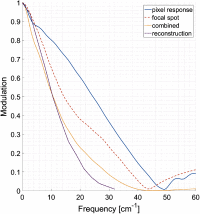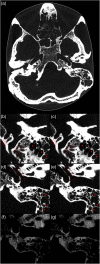Resolution characterization of a silicon-based, photon-counting computed tomography prototype capable of patient scanning
- PMID: 31620547
- PMCID: PMC6792007
- DOI: 10.1117/1.JMI.6.4.043502
Resolution characterization of a silicon-based, photon-counting computed tomography prototype capable of patient scanning
Abstract
Photon-counting detectors are expected to bring a range of improvements to patient imaging with x-ray computed tomography (CT). One is higher spatial resolution. We demonstrate the resolution obtained using a commercial CT scanner where the original energy-integrating detector has been replaced by a single-slice, silicon-based, photon-counting detector. This prototype constitutes the first full-field-of-view silicon-based CT scanner capable of patient scanning. First, the pixel response function and focal spot profile are measured and, combining the two, the system modulation transfer function is calculated. Second, the prototype is used to scan a resolution phantom and a skull phantom. The resolution images are compared to images from a state-of-the-art CT scanner. The comparison shows that for the prototype are detectable with the same clarity as on the reference scanner at equal dose and reconstruction grid, with more line pairs visible with increasing dose and decreasing image pixel size. The high spatial resolution remains evident in the anatomy of the skull phantom and is comparable to that of other photon-counting CT prototypes present in the literature. We conclude that the deep silicon-based detector used in our study could provide improved spatial resolution in patient imaging without increasing the x-ray dose.
Keywords: computed tomography; photon-counting; resolution; silicon.
© 2019 Society of Photo-Optical Instrumentation Engineers (SPIE).
Figures







